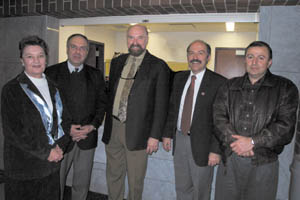Chris Tozlian
staff writer
On Monday, February 4th, Professor Levon Chookaszian lectured at CSU Fresno on “The Image of Secular Power in Armenian Art,” as part of the Armenian Studies Program Spring Lecture Series. Dr. Chookaszian presented a compelling survey of both Armenian and pre-Armenian art that spanned four millennia, beginning at approximately 2000 BC and moving well into the second millennium AD.

Those who attended the lecture inevitably left satisfied, as Prof. Chookaszian displayed his vast understanding of Armenian art and his insight gained due to years of study. Those who have not studied Armenian art may have understood Chookaszian’s lecture to be a simple overview of Armenian art, beginning with the pre-Armenian art that was the foundation for later fine metalwork, stone sculpture, and famous gospel manuscript illuminations. However, Chookaszian’s intention in surveying such a large amount of art was to lay the groundwork for his discussion of the “secular” side of Armenian art.
Anyone familiar with Armenian art clearly understands the profound effect that the fourth century conversion of Christianity had on it. What Prof. Chookaszian set out to accomplish in his lecture was to point out secular images in pre-Christian Armenian art, and then show the “drought” of secular imagery seen in the rest of the first millennium AD. However, the second millennium AD saw changes dealing with Armenian art’s secular side. Chookaszian’s many examples all pointed to the focal point of his discussion… the importance of secular imagery within Armenian art.
Dr. Chookaszian began by explaining the importance of secular imagery, pointing out the historical benefit derived from the surviving pre-Christian Armenian art. He explained that these surviving pieces of Armenian art can be compared with Iranian and Assyrian art. When doing so, historians find great stylistic similarities, which point to close relations between Armenia and its neighbors. Also, we see similarities in the dress and the actions of those portrayed on Armenian and non-Armenian pieces of art; historians look to these pieces of art when claiming similarities between cultures.

With the “Golden Age” of Armenian literature (5th century AD) came the beginnings of Armenia’s famed Gospel illuminations. Originally, there were only a small number of paintings in a Gospel, usually depicting the birth, the baptism, the crucifixion, and the resurrection of Jesus. However, as time passed, more pictures were inserted into manuscripts, most depicting Jesus, but some portraying the Four Evangelists, and others portraying Old Testament stories such as the Sacrifice of Isaac (often seen as a prefiguration to the coming of the Christ) and Jonah and the Whale.
As the centuries passed, the kings who sponsored the scribal production of Gospel manuscripts wanted their pictures to be inserted in the Gospels, as a memorial for the “good deed” of having a Gospel produced. The inclusion of portraits within Gospel illuminations has recently been given greater attention by historians, as they have realized that more information about Armenian royalty can be derived from these pictures. Yet this “royal” surge into the Gospel manuscripts all but ended in the latter part of the fourteenth century when Cilician Armenia fell to the Mamlukes; with this, there was no longer an Armenian king to patronize the scriptoriums that created the Armenian manuscripts. As a result, the noblemen and the well-to-do Armenian merchants kept this “tradition” alive. It was on this type of secularism that Professor Chookaszian focused the rest of his lecture.
Dr. Chookaszian went on to explain the significance of these pictures for both historians and Armenians alike; they open up an avenue to the past that was previously unexplored. Because of these secular manuscript illuminations that begin in the tenth century and continue until the eighteenth century domination of the printing press, we now have a greater glimpse of what life was like during the time of our ancestors. These pictures give us many hints into the life of those who came before us, including their style of dress, their culture, and obviously, the importance that was placed on the Bible. And so there we have it… the secular side of Armenian art. Perhaps most shocking is that, within Armenian art, there is the lack of a certain type of secular influence after Armenia’s fourth century conversion to Christianity. As a whole, the nation seemed to repel the idea of meshing the “Godly” with the “ungodly,” in art.
But the secular imagery seen cannot be discarded as trivial, for they do reveal to us a piece of history; this was the message that Prof. Chookaszian delivered. Though Armenia’s “secular” side is quite tame in relation to other nations’ art, Armenia’s secular art helps guide our understanding by giving us greater insight into the dress, culture, and spirituality of the Armenians of the past.
 Hye Sharzhoom Armenian Action
Hye Sharzhoom Armenian Action